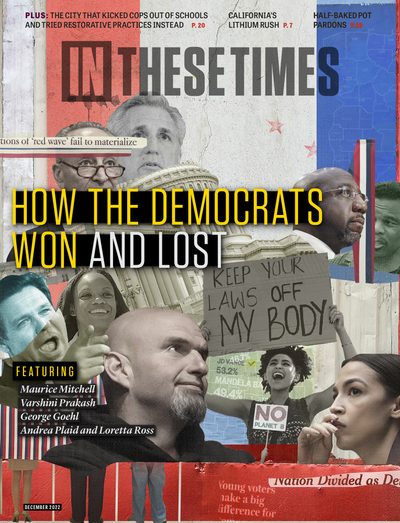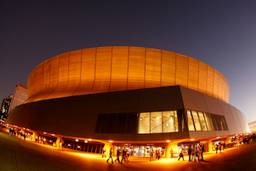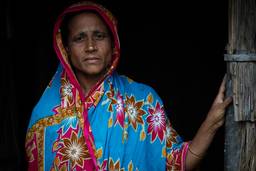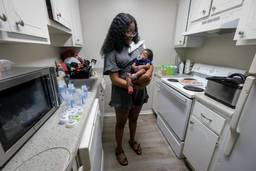The City That Kicked Cops Out of Schools and Tried Restorative Practices Instead
Here’s what happens when a school rethinks punishment.
Andy Kopsa
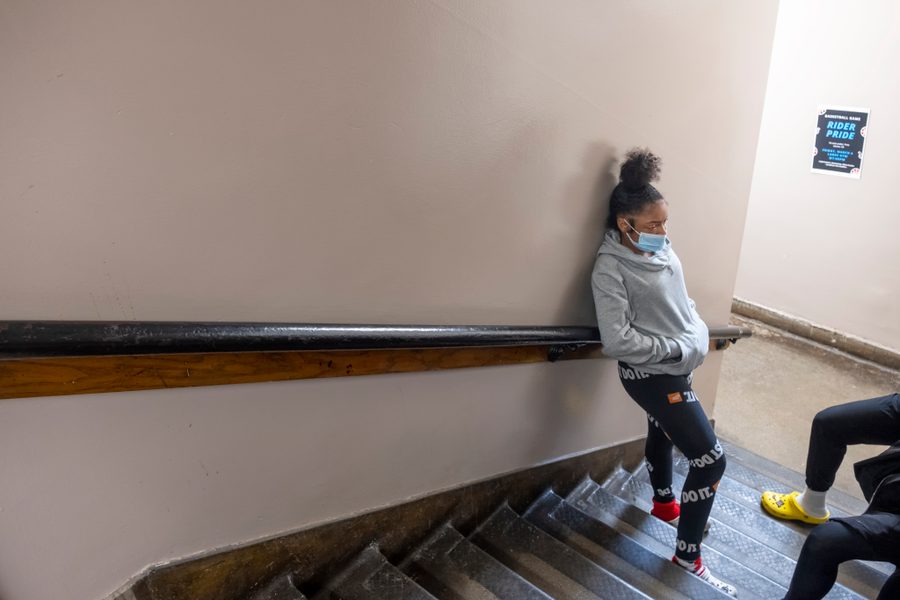
DES MOINES, Iowa — Wearing bright yellow Crocs, carrying a backpack and holding a clipboard stacked with papers, Ahmed Musa listens intently to a student. You would be forgiven for thinking Mr. Musa was a student himself; it is “staff dress like a student” day during spirit week at Theodore Roosevelt High School, and Mr. Musa looks the part.
Then again, Mr. Musa, 24, was a Roosevelt student not too long ago. He graduated in 2017.
He is talking with senior Jackie in a second floor hallway. She is animated, her purple and white braids falling across her baby blue N95 mask as she explains a problem. She is the president of the K-Club and there was an incident among members. The K-Club, she says, is about all things K-pop, from Korean music to food to movies to fashion. Mr. Musa laughs — he thought it was the “Kulture Club.”
Jackie goes on to give a broad overview of the situation: Racist and homophobic memes were posted in the group’s online chat of several dozen members. Tempers flared and arguments spilled over from social media into the classroom. Then a shouting match erupted during a club meeting. Fortunately, it didn’t come to blows. Members contacted the club’s teacher-advisor who contacted the school’s “restorative practices” team.
As a restoration facilitator, Mr. Musa’s job is to listen to problems and help students find solutions. Talking with Jackie that morning was the first step (a “prerestorative conference”) toward a formal “restorative circle.” Restorative circles are a group activity meant to help repair harm and restore relationships.
Jackie was one of several students I spoke with during two week-long visits to Roosevelt this year — once in the spring and once in the fall — to witness the school’s implementation of its new restorative practices program. Vanessa, a freshman struggling with the transition from remote learning during Covid, and Yonathan, a sophomore caught with drugs and weapons at school, were also among them. (Students involved in the RP program are referred to by first name to protect their privacy.)
Before the pandemic, armed officers known as “school resource officers,” or SROs, from the Des Moines Police Department would patrol the school hallways. But during the summer of racial justice marches and protests after the police murder of George Floyd, students, parents and community members spoke out against SROs at Des Moines School Board meetings. In the end, the police contract with the schools was terminated. After scrambling to make remote schooling work during the long, mournful slog of the pandemic, Des Moines Public Schools (DMPS) were left to find a way to reimagine school safety — and fast.
The district moved quickly to implement restorative practices, an increasingly popular educational model for school safety, violence prevention and mediation.
The 2021 – 2022 school year was a huge opportunity with the highest of stakes: DMPS could become one of the only districts in the nation to succeed in concurrently removing SROs and implementing restorative practices, or the district and its students could be thrown into crisis.
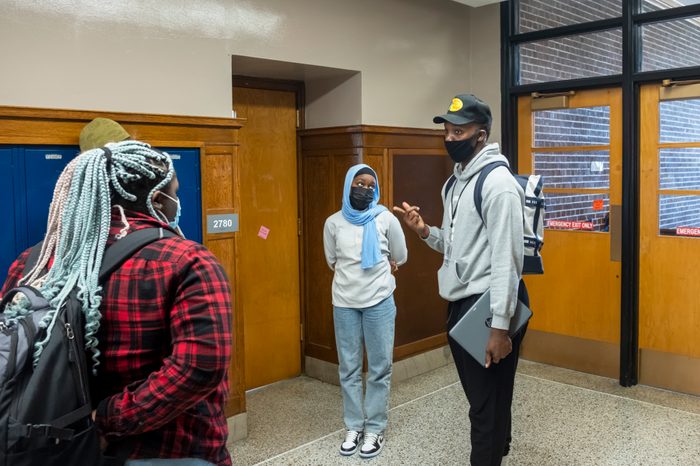
Restorative practices (RP) derive from “restorative justice,” which is used to bring together, in mutual agreement for mediation, the victim and the perpetrator of an offense. The goal is typically restitution for harm caused while helping the perpetrator restore community ties.
In education, “practices” is often swapped in for “justice” because it involves children who aren’t in criminal proceedings. Formal conflict resolution, after a dispute or rule-breaking, does play a role, but RP is also proactive, explains Anne Gregory, a Rutgers professor and one of the nation’s leading RP experts.
One core proactive practice is “check and connect.” This might be as simple as having teachers and staff say hi to each student as they enter the school, or asking a student between classes how their day is going. When there’s an issue, students can then sit down with a trusted adult to build “their own insight into themselves and what’s driving their behavior,” Gregory says.
Gregory emphasizes that relationship building is a two-way street. These micro-interactions of “check and connect” also change how teachers see students. They undermine “overgeneralization [and] negative stereotyping” and create space for understanding, Gregory says. When a student has “attendance problems,” for example, the right mindset involves “thinking about and understanding what’s going on for the family of that student that morning in getting out the door” — which is a “very different approach,” Gregory adds, from “sending a police officer to your house the fourth time you’re truant.”
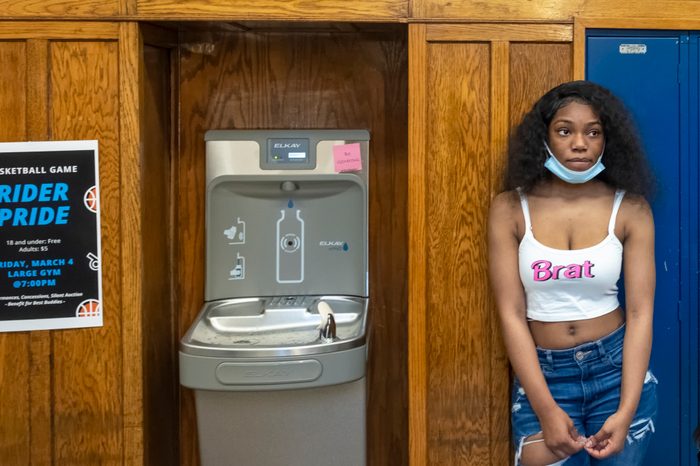
Roosevelt High School was known as “the million-dollar school” when it opened in 1923, a reflection of the project’s enormous price tag. Cover it in ivy and it would be at home on an East Coast college campus. It sits just north of what is now Interstate 235, which bisects Des Moines and was intentionally planned to cut through a once-thriving center of Black communities.
Forty-eight percent of Roosevelt’s 2,100 students are white, 25% are Black and 16% are Latino. They walk the halls completely unimpressed with the grand architecture — typical teenagers doing typical teenager things, including (sometimes) being disruptive.
On our way down one of the school’s many flights of stairs, Mr. Musa and I run into a shy young freshman, Vanessa, a known hallway roamer. At the beginning of the school year, Roosevelt teachers resoundingly asked RP staff to “clear the halls” — since students have to be in the classroom to learn and to keep out of trouble — so RP staff make it a point to check in with her.
Vanessa’s Covid years were 7th and 8th grade; now, as a freshman in a class of about 500, she faces a new environment with new rules and expectations. And people. So many people.
“Sometimes the classroom just got to be too much,” she tells me, her eyes darting around the hallway. “I just felt overwhelmed and really anxious so I had to just get out and walk around the halls by myself. Otherwise I would get too anxious.”
Vanessa says she sometimes asks to go to the “Think Tank,” a designated area created by RP staff for kids who violate school rules. While in the Think Tank as a punishment, students cannot talk, have outside meals or snacks and must turn off electronics. But the Think Tank can also be a respite; for Vanessa, it’s a safe space to deal with the anxiety that drove her to wander the halls.
“I would get overwhelmed and then I would ask to go to the Think Tank so I was able to do my work,” Vanessa says. “And Mr. Musa had snacks.” The snacks made a lasting impression.
When I drop by Roosevelt’s Think Tank with Mr. Musa, eight kids have opted to be there in lieu of suspension. Two girls are there because of a scuffle in the bathroom, though they say they were bystanders. Then there are a couple hallway roamers and two boys caught vaping.
In the Think Tank, students are required to do school work. In many cases, that’s a back catalog of assignments and writing about what they did, how it made them feel and how they might handle it differently in the future.
The subtle, important difference between the Think Tank and traditional in-school suspension, according to Jake Troja, DMPS director of school climate, is that students are there by choice. In the past, the message from the school district to students was, “You have a suspension, that’s it,” he says. Now, RP staff have a new message: “We’d love [for students] to be in class, but we can’t do that, so here’s another option.”
“It’s about power and authority,” Troja says.
RP coordinator Brandi Young remarks that she has seen, over and over, what helping students focus in the Think Tank can do for grades. “We have students who have gone from an F to a passing grade just within hours of sitting with [Mr. Musa],” by completing missing assignments, she says.
All of the coordinators I speak with agree that part of why RP works is because the team comes from the same neighborhoods as the students. Mr. Musa lives in the neighborhood and plays pick-up basketball with kids in his off-hours.
The relationships forged by check-and-connects can also help illuminate unnoticed issues. In Vanessa’s case, the RP team figured out she’s having trouble in class partly because she can’t see well. So they helped her get glasses.

Organizing and protests after George Floyd’s murder led school systems around the country to reconsider the use of SROs. Some moved money to restorative practices. In Los Angeles, under pressure from students, the school district cut its school police force by a third, and the city reinvested tens of millions from the police budget into school mental health counselors and restorative justice-trained “climate coaches.” In Chicago, an existing anti-SRO campaign by parents and youth activists got a lift from the protests — and the backing of the teachers union. The city agreed to empower local school councils to remove SROs, leading to a citywide reduction from 180 to 59, and schools reinvested the money in positions including social workers, security guards and restorative justice coordinators.
Des Moines went further.
During the summer uprising, the school district held a series of town halls to seek advice about how schools could be anti-racist. One overwhelming priority emerged: Get rid of SROs.
The armed SROs had the power to arrest students. They could respond to any incident on the school radio, whether requested or not. The school had no control over whether a particular student would be charged with regards to any particular incident.
“Seeing the way that police officers interacted with people that looked like me, I just had an automatic defense,” says East High School graduate Lyric Sellers, who is Black. “I just didn’t feel safe with them at all. And I knew that was true for a lot of students.”
The protests and the town halls inspired Sellers, then a junior, and East High School senior Endí Montalvo-Martinez to liberate the city’s schools from oppressive systems — which, to them, meant ousting SROs. Sellers and Montalvo Martinez worked with the Iowa Department of Human Rights to compile racial data about in-school arrests in Des Moines. Those findings were released at an October 2020 school board meeting and revealed that, between 2015 and 2019, the number more than doubled, from 273 annually to 590. What’s more, Black students made up 53% of all “complaints” (juvenile justice system terminology for “arrests”), despite accounting for only 20% of the student body.
And, even starker, an ACLU report released that month found that Black girls in Iowa were nine times more likely than white girls to be arrested.
During the next three months, the school board accepted public comments about SROs. At one December 2020 meeting, Jocelyn, a 17-year-old white student, shared that, while she was already in the principal’s office after having to defend herself against an attack from another student, “the principal and SRO came in very hostile and yelled at me, saying that I assaulted the hall monitor who split up the fight.” The hall monitor said they understood Jocelyn’s position. Nevertheless, after Jocelyn was questioned without a parent or legal counsel present, she was told she was being charged with assault and could only avoid jail time by signing up for a sort of “scared straight” program known as Second Chances.
“They took us to the Polk County Jail, warning us, ‘You don’t want to end up here,’” Jocelyn said. Despite it all, she thinks she got special treatment: “I cannot imagine how much worse my experience would have been if I was not a white girl.”
Sellers and Montalvo-Martinez also won the support of the teachers union, the Des Moines Education Association. “I think ultimately the students’ stories persuaded the union,” says Anne Cross, a Central Academy teacher and the Des Moines delegate for the Iowa State Teachers Association union. “The statistics and all the work the students put into collecting the data was helpful, but didn’t tell the whole story like the students’ lived experiences could.”
The district asked for reform — such as installing ununiformed and unarmed officers in schools — but the Des Moines police department responded, in February 2021, with a surprise termination of the contract. Sgt. Paul Parizek, Des Moines police public information officer, did not respond to multiple requests for comment.
Des Moines schools had already begun training teachers in restorative practices in 2018. With the $750,000 saved from the broken contract, the school district funded 20 new positions and hired specially trained RP staff across the city’s five public high schools. The district even invited Sellers and other students to observe the hiring process, and students picked up on red flags that staff missed, Sellers tells me, like candidates who called students “delinquents.”
Restorative Justice for Oakland and Youth (RJOY) was founded in 2005 and has pioneered the use of race conscious restorative justice nationwide. RJOY Executive Director Teiahsha Bankhead tells me that, while restorative justice has gained adherents in the West over the past 50 years with the decarceration and racial equity movement, “restorative justice draws upon thousands-of-years-old practices of peacemaking and healing by Indigenous communities around the world.”
Fania Davis, RJOY’s co-founder, trained in peacemaking practices in South Africa with a sangoma, a traditional Zulu healer. Other restorative justice traditions draw from practices of Indigenous North Americans (like the talking circles of the Abenaki), from the Mennonites and others in Canada, from the Aboriginal peoples of Australia, and heavily from the Māori in New Zealand. Today, restorative justice is increasingly used in the U.S. carceral system, particularly in the juvenile justice system; at least 46 states have incorporated it into state law.
With growing concerns over the school-toprison pipeline (including the role of SROs) and racism in school disciplinary practices — especially after a damning 2014 Obama administration report — the restorative model is spreading through the education world as well. In 2016, a third of U.S. public schools reported using restorative circles; by 2020, that number was 60%.
Teachers unions are generally supportive of RP, including the National Education Association and the American Federation of Teachers. Some unions, however, report hearing trepidation from some members. A national 2019 survey found that, while more than 80% of teachers said RP was “somewhat” or “very effective,” others expressed skepticism. One teacher commented, “It is good to practice it, but more punitive forms of discipline need to be enacted too.” Another: “Our school has focused on restorative justice and student conferences instead of any real consequences, and the students see that as getting away with bad behavior, so they continue.”
Gregory coauthored “The Starts and Stumbles of Restorative Justice in Education: Where Do We Go from Here?” in 2020 for the National Education Policy Center. When RP doesn’t work out, the study found, it’s often because schools have employed what Gregory calls “train and hope”; after a single training, teachers are expected to implement RP on top of everything else they’re juggling.
The more successful approach, Gregory tells me, gets buy-in from the whole school and requires ongoing support and accountability, which might include dedicated RP staff, ongoing trainings, centralized systems to share students’ social and emotional needs, and community engagements (such as food pantries, shelters and health clinics) for students in need.
Implemented with fidelity, according to Gregory, RP can genuinely reduce racial disparities in suspensions and expulsions, while keeping kids out of and away from the legal system — all while improving school climate and enhancing student development.
But conservative media outlets and foundations have amplified any criticism of RP as part of a broader narrative that public schools are violently out of control and liberals are soft on crime.
Catherine Augustine, a professor of policy analysis at Pardee RAND Graduate School who conducted one of the first rigorous studies of RP in public schools, disagrees that RP precludes consequences. While RP successfully reduced the number of suspensions in the Pittsburgh Public School District, which she studied, she says “no district, to my knowledge, is replacing suspensions for weapons, or for drugs or for alcohol, with purely a restorative approach.”
Deb Henry, science teacher and union rep at Roosevelt, sees RP working.
“Before [RP], there was no organized way to address needs of individual students,” she says. “They might be behavioral. They might be economic. Might be mental health issues. … We talked about educating the whole child, but we really struggled.”
In November 2021, three months after DMPS implemented the RP programs, local news station KCCI posted videos of Des Moines middle schoolers fighting. The headline: “Videos of violent high school [sic] fights concern [Des Moines Public Schools] parents.” Another local outlet picked up the story, then another. KCCI ran another story quoting a parent at a school board meeting demanding the return of SROs.
This same parent was quoted again by The Des Moines Register, other local outlets and Axios. Eventually, this same story was picked up by far-right media.
It gave the impression that violence between students was out of control.
“I don’t think that we have more fighting here [than anywhere else], I just think that it’s very easy, given our political climate in the state, [for media and politicians] to point fingers at Des Moines, a big city school,” Deb Henry says. “We have a diverse student body, and there are people on the Hill that see that as a negative.”
“We will see a reduction in some of that acting out and those negative behaviors” because of RP, she predicts, but “the reality is, they’re teenagers and their frontal lobes are not completely developed. And they’re going to fight. There will be fights in every school. That’s not going away.”
On March 7, days after my visit, a drive-by shooting near East High School killed 15-year-old Jose Lopez-Perez. Lopez-Perez wasn’t a student there, but that’s where the suspected gunmen were allegedly looking for him. Two other students were injured but survived.
Iowa Gov. Kim Reynolds, a staunch Trump supporter who calls for private school vouchers (she manipulatively calls them “scholarships”), was quick to blame the school system. “The tragedy is our system, our educational system, is letting these kids down,” she said at a press conference.
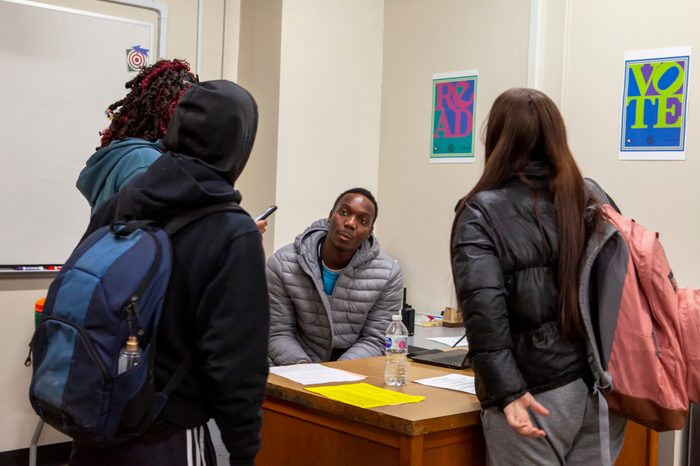
At the end of the 2021-2022 school year, everything is up in the air.
Rich Blonagin, administrator of alternative programs at Des Moines Public Schools, says the district is in a good place, considering how quickly it had to train new hires. The only quantitative goal for this first year was to reduce arrests, which happened. Districtwide, they fell from 538 to a stunning 98.
Fights requiring calls to police rose only slightly, from nine in 2019 (the most recent fully in-person year) to 13 in 2021. But students of color and students with disabilities were still disproportionately suspended.
Soon after I left, one Roosevelt student was kicked out for bringing knives and drugs to school.
I asked about the K-Club, and Blonagin tells me it disbanded. Mr. Musa is busy with end-of-year hubbub and not available to give me more details.
Gregory cautions that a year is not enough time to judge, and that quantitative measures may not tell the whole story.
“When we think about metrics,” she says, “we would want to think about things like school climate, sense of belonging, engagement, teacher wellness, how much absenteeism, how much teachers are calling in sick, teacher stress, you know, positive peer climate — these things can be a little more challenging to measure. … And then, how to capture those brief exchanges … that add up into building community and connection [which is the core of RP].”
I decided to return to Roosevelt in the fall to try and gauge that sense of community.
At the beginning of the 2022-2023 school year, the first yellow-orange leaves of the coming fall belie the 90 degree heat. Steven Schappaugh is in his second year as principal of Roosevelt. His office has an open door policy and, as we talk, a student walks in and goes directly over to a huge bakery box of cookies. She asks if she can have one as she lifts the lid to make her pick.
Schappaugh is candid about how the replacement of SROs with RP has changed his own thinking. “What I have learned is that there were times that I was asking for the SRO to be present that were not necessary, because we do have the skills and the resources to de-escalate situations,” Schappaugh says. “But when you’re in the midst of it, and you know you have this resource, it’s very easy” to just ask for police.
In the fall, Des Moines Public Schools released the results of the Iowa Department of Education’s annual Conditions For Learning survey, administered to students in March (unless opted out by their parents). Broadly, Roosevelt improved its overall score for students’ sense of physical safety, from 36% in 2019 to 54% in 2022. Feelings of emotional safety dropped, overall, by ten percentage points from 2019 to 2022, but that’s in line with a state-wide downturn during the pandemic. Students also reported improved relationships with peers, from 33% in 2019 to 50% in 2022.
One of the district’s goals for this school year is for teachers to feel empowered and equipped to use RP for basic disturbances, like backtalk and not following initial redirection. The district held a four-day RP training for teachers and staff in June. It also hired 13 more RP staff for the schools.
Each school now has a certified RP trainer on staff. At Roosevelt, that’s Tiffany Walker, one of the coordinators I met in the spring, who’s training groups of teachers who want to understand their role more clearly.
“We had a whole summer to come together and work to figure out how we’re going to structure the rest of the school year,” Mr. Musa says, including the new data systems for working across departments. “There’s no way a student can’t be successful.”
New this year is a data hub meant to serve as a sort of digitized relationship-building tool, where Roosevelt teachers, admins, nurses and staff can access and input student information, such as notes about struggles and strengths, or issues outside of school, like family problems and food insecurity.
“For the system to work in an ideal manner,” Schappaugh explains, “everybody that’s on the admin team has to be intimately aware of the moving parts.” In biweekly meetings, administrators discuss how RP is implemented in each department.
I also meet with Mr. Musa to talk about what happened with K-Club. He sees getting the students in a room together as a success, and the disbanding of the club as an acceptable outcome: “We can try to undo the harm, but sometimes there’s more to it, just a simple conversation won’t get over it. It might take years, it might take days, weeks.”
But, Mr. Musa adds, “If we can come to an agreement where kids can say ‘Hey, this [incident] happened, we’re gonna move on from it, and we don’t even have to speak to each other, but we can finish out the school year and both of us be successful in our own ways’ — that’s a winner.”
Next, I seek out a student’s perspective on the RP program.
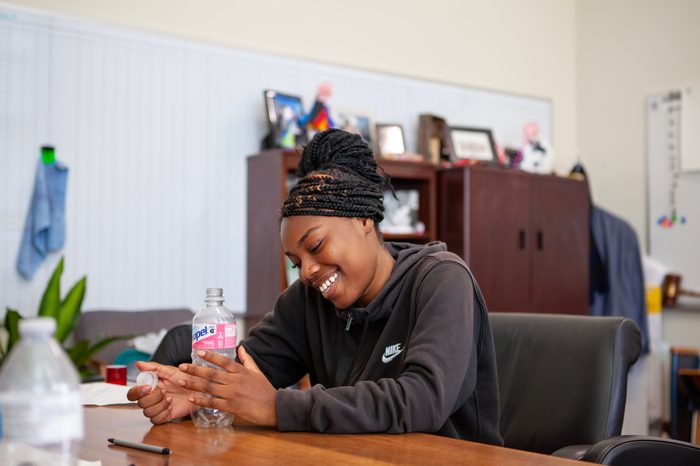
A confident and talkative teen girl sits across from me, ready for her follow-up, but I can’t figure out who she is. Then she starts talking about the previous year, the other time we met, how she was hallway roaming and anxious. Then it hits me: Vanessa.
Vanessa looks and sounds like a new kid. She speaks easily, confidently. Her smile is genuine, no longer the nervous, barely there, tentative smile from the spring.
We start talking about what has changed. Like for all the other students, staff, teachers — everyone — I spoke with over the course of my reporting, Covid has been the great uniter. There’s life before, and life after.
For kids like Vanessa, Covid was especially tough.
“Yeah, so it was really hard, plus meeting so many new people, wearing masks… it was, like, new to me,” she says. “I always used to just leave and walk the hallways or, like, follow friends. … I was always in the hallways and wasn’t really doing good so I had to attend summer school.”
She feels lucky there was a Think Tank. She mentions “everything Mr. Musa did for me,” because, so far this year, she says she is on a good path. “I feel like it’s going smoother this year and better. I go to all my classes.
“It’s like someone’s just right there to help you in person. Roosevelt is a really good place. Like, I love it here. It teaches you a lot, and you can be successful, you can be safe.”
She has glasses now for the classroom, she tells me.
Vanessa is one of several students who say they don’t see nearly as many people in the hallways this fall, and none have heard of any fights. The Think Tank remains open, but it isn’t like it was in the spring.
When I speak again with Gregory, I tell her about Vanessa. With the caveat that “there’s lots that’s going on developmentally for her, no doubt,” Gregory notes the importance of the nonpunitive approach in Vanessa’s situation: “The school took a trauma-informed response, tapping into her social and emotional needs, as opposed to saying, ‘You’re violating policy of leaving the room.’ In a lot of school districts, that could have led eventually to suspension, which could have initiated a negative trajectory.”
Of the three tiers of intervention undertaken by Roosevelt’s RP program, Vanessa is an example of the second. The first is the check-and-connects, tasked to every level of school staff.
The second tier, building on the first, happens when a need is identified by teachers, staff or the RP team, such as Vanessa’s anxiety or trouble seeing in class. The K-Club circle’s need for conflict resolution is another example.
Tier three comes in when students allegedly break the law, cause serious physical harm or otherwise violate major school policies. In years past, the school might have expelled a student outright. Now, the RP team helps administer a deferred expulsion program.
While other diversion programs have tried to keep kids in school, the RP deferral goes further. The alternative placement program provides “a safe space,” and facilitators like Musa visit their students at least once a week.
“I go Friday — if you are available, you can come,” he says. So I do.
Urban Dreams, a human-services organization that provided five of DMPS’s RP coordinators, including Mr. Musa, also serves as an alternative placement space for students who are part of the expulsion deferral program. A community hub that provides events like the “Trunk or Treat” Halloween Party and free annual pre-winter car check-ups, it sits on the corner of Forest and Sixth in the historically Black district cut through by Interstate 235. There is a push for renewal of this neighborhood, especially along Sixth Avenue. New developments are popping up, small business grants are being awarded to majority Black-owned businesses and the four-lane road looks freshly resurfaced with broad medians that will eventually be covered in grass, maybe even native Iowa milkweed or wildflowers.
Community-building in RP, Gregory tells me, can refer to the school community — the physical building bustling with kids — or, more broadly, to families, neighborhoods and the community organizations that partner with schools to provide wraparound services.
When I walk into Urban Dreams, Mr. Musa is deep in conversation with a student at the end of a conference table. Eight kids, from middle school to high school, are serving out-of-school suspensions and working through a virtual school day.
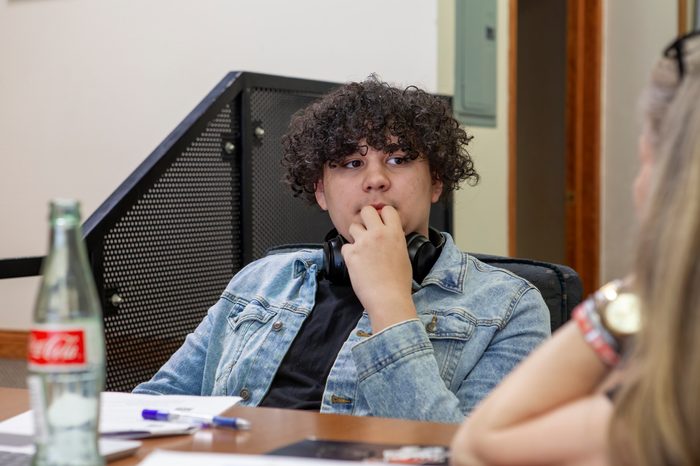
I ask Mr. Musa and the student if I can hang out while they talk. Mr. Musa says, “Sure”; the student shrugs a sheepish consent; they both laugh. The two talk easily together, even with me sitting there.
Thinking back to the spring, I am reminded of the way the RP team talked about students they worked with. Ms. Walker told me they think of them as “their babies” and treat the kids with the kindness and respect they would want their own children to get.
Mr. Musa then lets the student know I’m OK to talk with.
He introduces himself as Yonathan and I ask, basically, what are you in for? He laughs and says, “I was suspended in March for weapons and drugs,” the day before his 16th birthday. He shakes his head. He says he brought cannabis vaping cartridges and four knives to school, and “one was over five inches, so that’s a felony right there.” He was already on probation; he says he didn’t want to talk about it; I say that’s OK.
The end of SROs hasn’t changed the school policy to call police about weapons and drugs.
I tell Yonathan about the time I was arrested when I was 16, and his eyes open a bit. I spent 90 days in a locked rehab facility for drunk driving — I explain it was less of a rehab and more of a kid prison.
I say there was nothing back then like Mr. Musa and the RP team — maybe he’s lucky.
He nods.
In Yonathan’s case, it’s not when he will be allowed back to school, but if.
Yonathan’s mom, whom he lives with, is supportive, he tells me. But he knows he’s been a lot to deal with. They talked, after his diverted expulsion, about school, life and choices. She was a drop-out, he says, and she told him, “You don’t want to drop out. It’s a hard road.” She said that, although she has managed to make it, it’s better to stay in school and just get the diploma.
I ask Yonathan what his favorite subject is. He answers immediately: history. He loves learning about World War II and Vietnam, Korea. He thinks his maternal grandfather served in World War II and he says uncles fought in other wars.
Reintegrating students like Yonathan and trying out more formal restorative circles are some of the challenges ahead for the fledgling RP program. It could face political headwinds if Iowa’s GOP politicians decide to play up urban crime and public-school violence — especially under the glaring lights of the looming 2024 Iowa caucuses.
Ultimately, though, the RP team at Roosevelt — and throughout the district — tries to keep themselves and the students in the present, and not worry about what politicians may or may not do. They just work on building relationships every day.
Deb Henry tells me that their work is bringing subtle changes. “I think that in the halls and in the building, there are changes in the attitudes of kids toward authority.” Her classroom is next to a student hangout spot. When she came into the hallway and told them to move along, she used to be cursed at. Now, she says, “every single time, they will apologize.
“I think there’s a sense now among the kids that we are there for them,” she says.
This story was reported with the support of the Leonard C. Goodman Institute for Investigative Reporting.
Andy Kopsa is an award-winning investigative reporter based in New York City, though raised on an Iowa farm. Her work on government corruption, justice reform, reproductive freedom and international affairs has appeared in The New York Times, The Nation, The Guardian, Al Jazeera, Foreign Policy and others.
